大学英语经典阅读文章
大学经典英语作文带翻译-你为什么上大学

College is a place where people go to increase their knowledge, to prepare for a future career, to get a new experience, to meet new people. Of cause, different people have different reasons to attend college, but all of them want to change their life for better. In this essay I will give the basic reasons and explain why people go tocollege.First of all, every person wants to improve his or her life. So, college is one of the places that helps one get more from his life, to meet more opportunities. Knowledge is a power that can be gotten through studding. After graduation people may get better job and completely change their career and life.Second of all, people go to a college to get a new life experience, which is very important because students learn to take care of themselves. Many of them work during their college years and earn their first money. It is really great and exiting. They learn how to save money and keep house, how to arrange their time in order to get all things done etc.Additionally, students learn how to co-operate and communicate with each other. Many of them have to live with a roommate. From the first sight, it may seem difficult to live with a completely strange person, but it helps one to be friendlier, more supportive and it helps you save some money.In summary, I would like to add that graduation is one of the major goals people try to accomplish in their life, because after that many beautiful, exciting changes will happen. That changes will make a person proud of himself.大学是一个地方,人们去增加他们的知识,为未来的职业做好准备,以获得新的经验,以满足新的人。
大学英语四六级经典阅读:Dream What You Want to Dream 敢想敢做.doc
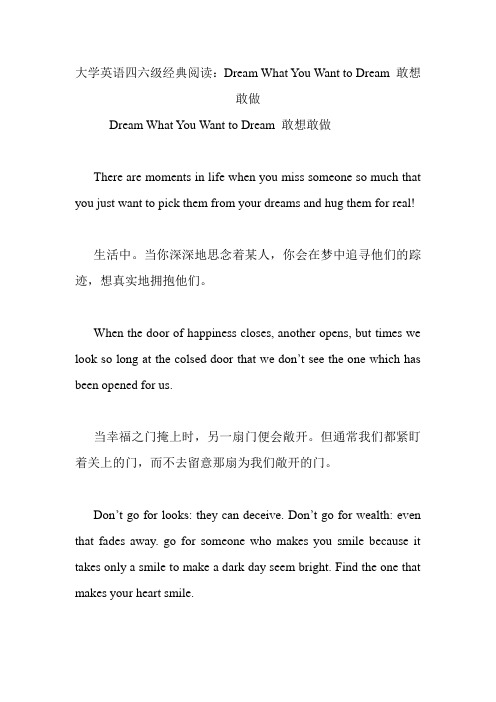
大学英语四六级经典阅读:Dream What You Want to Dream 敢想敢做Dream What You Want to Dream 敢想敢做There are moments in life when you miss someone so much that you just want to pick them from your dreams and hug them for real!生活中。
当你深深地思念着某人,你会在梦中追寻他们的踪迹,想真实地拥抱他们。
When the door of happiness closes, another opens, but times we look so long at the colsed door that we don’t see the one which has been opened for us.当幸福之门掩上时,另一扇门便会敞开。
但通常我们都紧盯着关上的门,而不去留意那扇为我们敞开的门。
Don’t go for looks: they can deceive. Don’t go for wealth: even that fades away. go for someone who makes you smile because it takes only a smile to make a dark day seem bright. Find the one that makes your heart smile.不要一味地追求外貌,因为它们会欺骗人。
不要一味地追求财富。
它们终归会消失。
去追求那些使你欢笑的人,因为他们的一个微笑会使你暗淡的生活变得光彩夺目。
去追寻使你真正幸福快乐的人吧。
Dream what you want to dream: go where you want to go: be what you want to be , because you have only life and one chance to do all the things you want to do.做你想做的美梦,去你想去的地方,成为你想成为的人。
大学英语四六级经典阅读:A Story of Hope 一个关于希望的故事.doc

大学英语四六级经典阅读:A Story of Hope 一个关于希望的故事A Story of Hope 一个关于希望的故事Emma was diagnosed with breast cancer when she was 33 years old. The cancer was in one of her lymph glands, which resulted in a very radical mastectomy. “There was no chemother apy back then, only the knife,” she said. Talking about her cancer is not something that comes easily for her.艾玛在33岁的时候被诊断患有乳腺癌。
癌症在她的一个淋巴腺体中,因此只能将乳房彻底切除。
她说:”那时还没有什么化学疗法,只能动手术。
”谈起那次癌症,对她来说还真不是一件简单的事情。
“A long time ago people were ashamed,” she said, “I can remember when I went into surgery, there were so many young doctors there to watch the operation.” The doctors told her that she was cut so terribly that she was in the hospital for six weeks.“那时候的人还挺害羞的,”她说道,”我很清楚地记得我动手术时,有很多年轻的医生在观察手术过程。
”医生告诉她,她的乳房切除的很彻底,得住院六个星期。
After she had the surgery, there were no follow-up treatments, only a few x-rays. “I didn’t heal for eight months and I finally had to go to New Orleans. I could not do anything with my arm. I had it strapped down to my side but it didn’t bother me,” she says. Emma would not believe the doctors when they told her she would not be able to use her arm again, so she began to exercise the arm herself.手术结束后,没有进行后续治疗,只是例行做了X光检查。
大学生经典英语作文-读书的好处TheBenefitsofReading
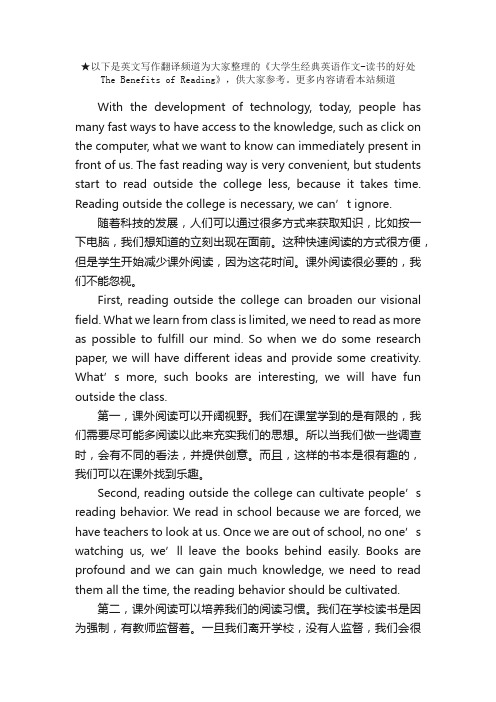
★以下是英文写作翻译频道为大家整理的《大学生经典英语作文-读书的好处The Benefits of Reading》,供大家参考。
更多内容请看本站频道With the development of technology, today, people has many fast ways to have access to the knowledge, such as click on the computer, what we want to know can immediately present in front of us. The fast reading way is very convenient, but students start to read outside the college less, because it takes time. Reading outside the college is necessary, we can’t i gnore.随着科技的发展,人们可以通过很多方式来获取知识,比如按一下电脑,我们想知道的立刻出现在面前。
这种快速阅读的方式很方便,但是学生开始减少课外阅读,因为这花时间。
课外阅读很必要的,我们不能忽视。
First, reading outside the college can broaden our visional field. What we learn from class is limited, we need to read as more as possible to fulfill our mind. So when we do some research paper, we will have different ideas and provide some creativity. What’s more, such books are interesting, we will have fun outside the class.第一,课外阅读可以开阔视野。
大学英语四六级经典阅读:昨天 今天 还有明天.doc

大学英语四六级经典阅读:昨天今天还有明天Yesterday Today and Tomorrow 昨天今天还有明天There are two days in every week about which we should not worry, two days which should be kept free from fear and apprehension. One of it is Yesterday, with its mistakes and cares, its aches and pains. Yesterday has passed forever beyond our control. All the money in the world cannot bring back Yesterday. We cannot undo a single act we performed. Nor can we erase a single word we said - Yesterday is gone!每个星期有两天我们不用担心,没有恐惧,没有忧愁。
其中一天是”昨天”,有过失和忧虑、辛酸和痛苦。
昨天已是过眼烟云。
再也无法掌控。
世上所有的金钱都无法将其挽回。
我们既不能为过去做过的事反悔,也不能收回我们说过的每一句话,因为昨日已逝。
The other day we shouldn’t worry about is Tomorrow with its impossible adversities, its burdens, its large promise and poor performance. Tomorrow is also beyond our immediate control. Tomorrow’s sun will rise, either in splendor or behind a mask of clouds - but it will rise. Until it does, we have no stake in Tomorrow,for it is yet unborn.另一天无须担心的是”明天”。
大学英语四六级经典阅读:攀登峰顶.doc

大学英语四六级经典阅读:攀登峰顶Reaching the Top of the Mountain 攀登峰顶Whenever the sun dropped and the blue sky came up, my father and I used to climb the mountain near my house. Walking together, my father and I used to have a lot of conversations through which I learned lessons from his experiences. He always stressed to me, “You should have objectives and capacity like the mountain.”每当太阳快要下山,蔚蓝的天空浮现出来时,我和我的父亲总会去攀登我家附近的那座大山。
我们一边攀登一边聊起很多话题。
父亲的经验之谈让我受益匪浅。
他总是鼓励我:”你要有山一般坚定的目标和宽阔的胸怀。
”This has largely influenced my life. Without such mountaineering opportunities, we couldn’t have had enough time to spend together because my father was very busy himself. I believe mountaineering is really beneficial. It gave me time to talk with my father and to be in deep contemplation as well as develop my patience. I loved traversing the top of the mountains, getting away from the routine of city life, the noise and the pollution, and being able to breathe fresh air.这些话对我的人生产生了深刻的影响。
大学英语经典阅读文章
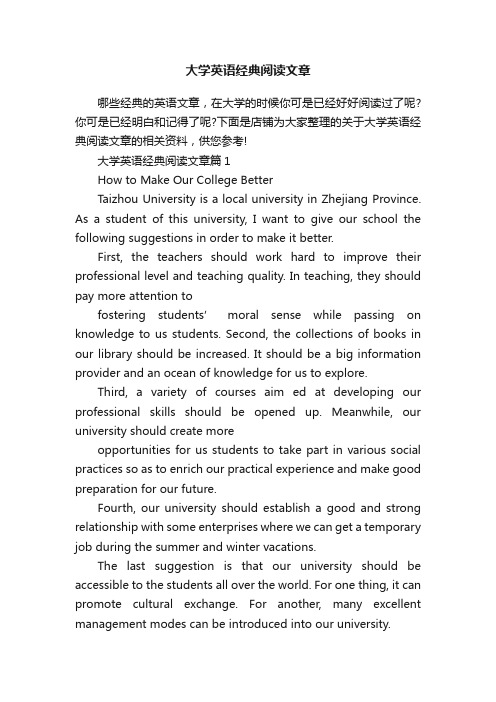
大学英语经典阅读文章哪些经典的英语文章,在大学的时候你可是已经好好阅读过了呢?你可是已经明白和记得了呢?下面是店铺为大家整理的关于大学英语经典阅读文章的相关资料,供您参考!大学英语经典阅读文章篇1How to Make Our College BetterTaizhou University is a local university in Zhejiang Province. As a student of this university, I want to give our school the following suggestions in order to make it better.First, the teachers should work hard to improve their professional level and teaching quality. In teaching, they should pay more attention tofostering students’ moral sense while passing on knowledge to us students. Second, the collections of books in our library should be increased. It should be a big information provider and an ocean of knowledge for us to explore.Third, a variety of courses aim ed at developing our professional skills should be opened up. Meanwhile, our university should create moreopportunities for us students to take part in various social practices so as to enrich our practical experience and make good preparation for our future.Fourth, our university should establish a good and strong relationship with some enterprises where we can get a temporary job during the summer and winter vacations.The last suggestion is that our university should be accessible to the students all over the world. For one thing, it can promote cultural exchange. For another, many excellent management modes can be introduced into our university.In a word, all the students, the staff and the faculty should make their efforts to develop our university. I believe it will have a much brighter future.大学英语经典阅读文章篇2On Playing TruantNowadays, increasing numbers of college students are playing truant, which has become the focus and concern of both teachers and students. There are many reasons to account for their absences from classes.Undoubtedly, the students who play truant are the first to blame for it. Some of them cut their classes because they show no interest in studying. They indulge themselves in surfing the internet or playing computer games. Or they just sleep in the dormitory owing to low temperature outside in winter. Others value making money and gaining working experience more than getting educated. They even devote much of their class time to part-time jobs. Of course, teachers’ d ull lectures are another reason for students’ failure to attend classes.Repeated absences will do great harm to students themselves, which will affect their ability to finish their course s . It is likely that they will be expelled out of school if they make a habit of skipping classes. It is time to take some efficient measures. Attendance record s should be regularly kept and submitted to school committee if requested so as to maximize their learning opportunity and professional development. To the students, awareness of self-discipline should be raised . To the teachers, their lectures need to be made more interesting, lively and attractive. Anyway, to stop playing truant needs joint efforts from students and teachers.大学英语经典阅读文章篇3The Teacher I Like BestI have been studying for more than twelve years, meeting a variety of teachers. As a student, there is no doubt that teachers often mean so much to me. They not only pass on knowledge to us, but also help us to acquire abilities, skills and develop our mind.I am thankful to those teachers who once taught me. Although years have obscured many names of my teachers, but not the name of my Chinese teacher –Wang Xiaofu, who was in charge of my class when I was in high school. In my eyes, she is an extraordinary woman with ordinary appearance. No one thinks she is beautiful but they all agree that she is lovely, confident and eloquent. She enjoys talking and communicating with others. Anyone who has once talked with her is surely attracted by her and has a deep impression of her sharp mind.In addition, her outstanding teaching style also has left a deepimpression on me. As we know, the three years in high school is the toughest period to us students. However, Mrs. Wang tried her best to relieve our stress and pressure. She tried to make us understand that learning means more than immerse ourselves into books. She always encouraged us and after school, she even joined us to play games and do some sports such as running and playing basketball. Though life then was stressful, we experienced sweetness and pleasure of life with my teacher.After class, she is more a friend than a teacher to us all. She treated us as her children and took good care of us. I still remember what she did for me after an important exam. I didn’t do well in the exam and was in low spirit. What’s worse, myfriends didn’t talk to me because of my bad temper. I felt so frustrated and confused about what to do next. Mrs Wang realized it and called me out of the classroom. T o my surprise, she invited me to have a dinner with her instead of criticizing me and told me a pile of reasons. At the table she just talked with me happily as if nothing had happened. I understood her intention. She was telling me in a special way: “Don’t let your frustra tion last long. Keep calm.All difficulties will be a past thing.” I was so moved.That is the teacher I like most. I think I will remember her for ever.。
大学英语 报刊英语阅读译文8篇

报刊阅读译文第一单元每一个高中毕业生都渴望进入大学,但是,如今美国学生却不得不面临他们预料和现实中学校能提供的助学金差异越来越大的事实。
有时,他们进入理想中的大学梦想就这样破碎了。
如何才能成功申请到奖学金呢?在接下来的段落中,一项分析调查会为你揭开许多美国申请财政资助的秘诀。
当肯塔基州莱克星顿的双包胎BREEN,在上个秋天开始申请大学时,他们的父亲刚在田纳西州的一家医学公司找到一份审计员的新工作,而他们母亲为了能和父亲一起,将要失去她作为一个残疾人教育助手的工作。
他们希望学校能够看到这个事实,提供足够的助学金使他们能够上学。
“中产阶级的人真的过着一种收支刚刚相抵的生活。
”Matthew说:“他们每年赚不到35000美元,那么大笔钱对他们来说是荒谬的。
”在3月份,Matthew和Ryan开始收到厚厚的信,,也学到了校园经济的第一课,有些学校提供的奖学金可供Breen兄弟勉强支付上学的费用,而其他一些学校给他们的选择只能是贷上一大笔钱。
Matthew说:“你的财力未必能决定你可以获得多少助学金,这真是让人泄气。
”申请人过于简单化的假想和过于激烈的竞争学校财力资助之间的差距从来没有这么大过。
一篇上星期发布的报道证明了Breen一家的情况是非常典型的。
当然,许多政府官员、学校管理人和教育出借人确实尽了他们最大的努力来帮助学生支付学校费用。
一些最好的大学,正逐渐变得更慷慨,保证尖子生得到足够的资助来付学费。
越来越多的州和乡镇也为三好学生在社区或州立大学提供全额奖学金。
然而,不幸的是,越来越多的学校正在采取秘密的和复杂的资助计划,这通常使家庭需支付现款的数量增多。
与此同时,学生贷款条约和教育救助计划最近发生了如此戏剧性的转变。
以致于这些原本无法负担的人,最终比实际付的更多。
但是在刊登在《美国新闻与世界报道》的分析透露了一个可以使大学更容易被付得起的计划。
这个分析是经过研究了数以百计的2006年录取通知书以及和调查者,学校财力资助官员,出借人,财政计划者和学生的访谈而得出的。
大学英语短文带翻译 大学英语短文阅读3篇
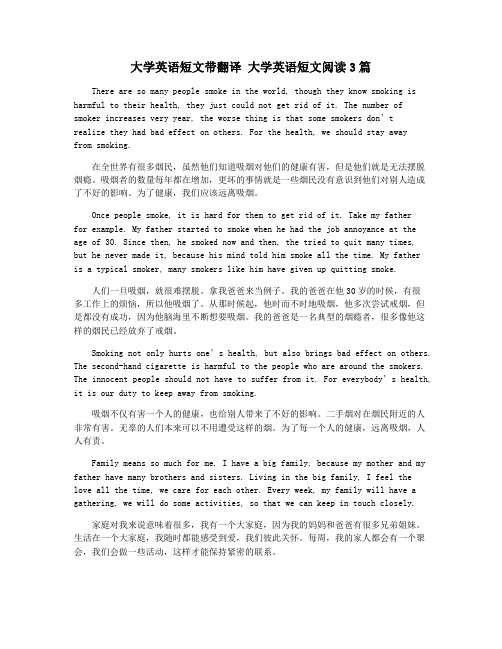
大学英语短文带翻译大学英语短文阅读3篇There are so many people smoke in the world, though they know smoking is harmful to their health, they just could not get rid of it. The number of smoker increases very year, the worse thing is that some smokers don’trealize they had bad effect on others. For the health, we should stay awayfrom smoking.在全世界有很多烟民,虽然他们知道吸烟对他们的健康有害,但是他们就是无法摆脱烟瘾。
吸烟者的数量每年都在增加,更坏的事情就是一些烟民没有意识到他们对别人造成了不好的影响。
为了健康,我们应该远离吸烟。
Once people smoke, it is hard for them to get rid of it. Take my fatherfor example. My father started to smoke when he had the job annoyance at the age of 30. Since then, he smoked now and then, the tried to quit many times,but he never made it, because his mind told him smoke all the time. My fatheris a typical smoker, many smokers like him have given up quitting smoke.人们一旦吸烟,就很难摆脱。
拿我爸爸来当例子。
阅读经典书本的好处 The Advantages of Reading Classic Books(大学英语作文)
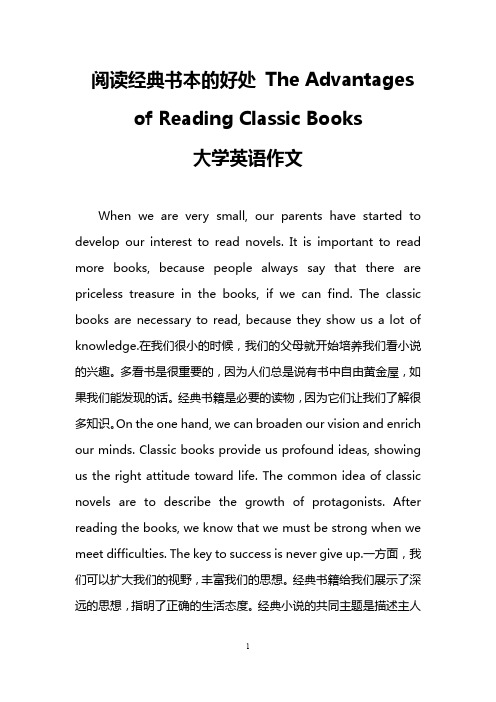
阅读经典书本的好处The Advantages of Reading Classic Books大学英语作文When we are very small, our parents have started to develop our interest to read novels. It is important to read more books, because people always say that there are priceless treasure in the books, if we can find. The classic books are necessary to read, because they show us a lot of knowledge.在我们很小的时候,我们的父母就开始培养我们看小说的兴趣。
多看书是很重要的,因为人们总是说有书中自由黄金屋,如果我们能发现的话。
经典书籍是必要的读物,因为它们让我们了解很多知识。
On the one hand, we can broaden our vision and enrich our minds. Classic books provide us profound ideas, showing us the right attitude toward life. The common idea of classic novels are to describe the growth of protagonists. After reading the books, we know that we must be strong when we meet difficulties. The key to success is never give up.一方面,我们可以扩大我们的视野,丰富我们的思想。
经典书籍给我们展示了深远的思想,指明了正确的生活态度。
经典大学英语美文欣赏经典英语短文美文欣赏

经典大学英语美文欣赏经典英语短文美文欣赏教材是教学过程中至关重要,不可或缺的部分,对教与学的各个方面都有着深刻的影响。
大学英语教材是大学英语教学的重要载体,也是深化教学改革,培养创新人才的重要保证。
下面小编带来的经典大学英语美文欣赏,欢迎阅读!经典大学英语美文欣赏篇一Put time where love isDuring my 25 years as a marital(婚姻的) therapist, I have seen hundreds of people disappointed over unfulfilling relationships. I have seen passion turn to poison. I have grieved with patients for the love they lost or never found.“We seemed to love so much, but now it's gone,“ one woman lamented(哀悼)to me. "Why do I feel so lonely every night even when he is right there beside me? Why can't marriage be more than this?"It can. I was once invited to the 60th-anniversary celebration of a remarkable couple. I asked the husband, Peter, if he ever felt lonely and wondered where the love between him and Lita had gone. Peter laughed and said, "If you wonder where your love went, you forgot that you are the one who makes it. Love is not out there; it's in here between Lita and me."I know we can love deeply, tenderly(温和地) and lastingly. I have seen such love, and I have felt such love myself. Here are the law I have discovered for such lasting and loving relationships---put time where love is.A fulfilling marriage begins when two people make time together their No.1 priority. If we hope to find love, we must first find time for loving.Unfortunately, current psychology rests on the model of the independent ego. To make a lasting marriage we have to overcome self-centeredness. We must go beyond what psychologist Abraham Maslow called "self-actualization" to "us-actualization". We have to learn to put time where love is.Many couples have experienced a tragic moment that taught them to value their time together. One husband related how he sat trapped in his car after a crash. His wife was outside, crying and banging on the window. "I thought I was going to die before we had enough time together." He told me. "Right then I promised to make the time to love my wife. Our time is our own now, and those hours are sacred(神圣的)."经典大学英语美文欣赏篇二AmbitionIt is not difficult to imagine a world short of ambition(野心,抱负) . It would probably be a kinder world: without demands, without abrasions(擦伤,磨损) , without disappointments. People would have time for reflection. Such work as they did would not be for themselves but for the collectivity(集体) . Competition would never enter in. Conflict would be eliminated, tension become a thing of the past. The stress of creation would be at an end. Art would no longer be troubling, but purelycelebratory(快乐的) in its functions. Longevity would be increased, for fewer people would die of heart attack or stroke caused by tumultuous(吵闹的) endeavor. Anxiety would be extinct. Time would stretch on and on, with ambition long departed from the human heart.Ah, how unrelieved(未减轻的) boring life would be!There is a strong view that holds that success is a myth, and ambition therefore asham(假装,骗子) . Does this mean thatsuccess does not really exist? That achievement is at bottom empty? That the efforts of men and women are of no significance alongside the force of movements and events now not all success, obviously, is worth esteeming, nor all ambition worth cultivating. Which are and which are not is something one soon enough learns on one’s own. But even the most cynical secretly admit that success exists; that achievement counts for a great deal; and that the true myth is that the actions of men and women are useless. To believe otherwise is to take on a point of view that is likely to be deranging(扰乱) . It is, in its implications, to remove all motives for competence, interest in attainment(成就) , and regard for posterity(子孙) .We do not choose to be born. We do not choose our parents. We do not choose our historical epoch(新纪元) , the country of our birth, or the immediate circumstances of our upbringing(教养) . We do not, most of us, choose to die; nor do we choose the time or conditions of our death. But within all this realm(领域) of choicelessness, we do choose how we shall live: courageously or in cowardice(怯懦) , honorably or dishonorably, with purpose or in drift. We decide what is important and what is trivial(不重要的) in life. We decide that what makes us significant is either what we do or what we refuse to do. But no matter how indifferent the universe may be to our choices and decisions, these choices and decisions are ours to make. We decide. We choose. And as we decide and choose, so are our lives formed. In the end, forming our own destiny is what ambition is about.经典大学英语美文欣赏篇三Smile微笑Smile at each other, smile at your wife, smile at your husband,smile at your children, smile at each other―it doesn’t matter who it is―and that will help you t o grow up in greater love for each other.Many Americans are familiar with The Little Prince, a wonderful book by Antoine de Saint-Exupery. This is a whimsical(古怪的) and fabulous book and works as a children’s story as well as a thought-provoking(刺激的) adult fable. Far fewer are aware of Saint-Exupery’s other writings, novels and short stories.Saint-Exupery was a fighter pilot who fought against the Nazis and was killed in action. Before World War II, he fought in the Spanish Civil War against the fascists. He wrote a fascinating story based on that experience entitled The Smile. It is this story which I'd like to share with you now. It isn't clear whether or not he meant this to be autobiographical or fiction. I choose to believe it to be the former.He said that he was captured by the enemy and thrown into a jail cell. He was sure that from the contemptuous(轻蔑的,侮辱的) looks and rough treatment he received from his jailers he would be executed the next day. From here, I’ll tell the story as I remember it in my own words."I was sure that I was to be killed. I became terribly nervous and distraught(发狂的) . I fumbled in my pockets to see if there were any cigarettes, which had escaped their search. I found one and because of my shaking hands, I could barely get it to my lips. But I had no matches, they had taken those.“I looked through the bars at my jailer. He did not make eye contact with me. After all, one does not make eye contact with a thing, a corpse. I called out to him 'Have you got a light?' Helooked at me, shrugged and came over to light my cigarette."As he came close and lit the match, his eyes inadvertently(不注意地) locked with mine. At that moment, I smiled. I don’t know why I did that. Perhaps it was nervousness, perhaps it was because, when you get very close, one to another, it is very hard not to smile. In any case, I smiled. In that instant, it was as though a spark jumped across the gap between our two hearts, our two human souls. I know he didn’t want to, but my smile leape d through the bars and generated a smile on his lips, too. He lit my cigarette but stayed near, looking at me directly in the eyes and continuing to smile."I kept smiling at him, now aware of him as a person and not just a jailer. And his looking at me seemed to have a new dimension, too. 'Do you have kids?' he asked."'Yes, here, here.' I took out my wallet and nervously fumbled for(摸索) the pictures of my family. He, too, took out the pictures of his family and began to talk about his plans and hopes for them. My eyes filled with tears. I said that I feared that I'd never see my family again, never have the chance to see them grow up. Tears came to his eyes, too.Suddenly, without another word, he unlocked my cell and silently led me out. Out of the jail, quietly and by back routes, out of the town. There, at the edge of town, he released me. And without another word, he turned back toward the town.My life was saved by a smile.Yes, the smile―the unaffected(自然的,真挚的) , unplanned, natural connection between people. I tell this story in my work because I’d like people to consider that underneath all the layers we construct to protect ourselves, our dignity, our titles, ourdegrees, our status and our need to be seen in certain ways―undernea th all that, remains the authentic(真实的) , essential self. I’m not afraid to call it the soul. I really believe that if that part of you and that part of me could recognize each other, we wouldn’t be enemies. We couldn’t have hate or envy or fear. I sadly conclude that all those other layers, which we so carefully construct through our lives, distance and insulate(隔离,使孤立) us from truly contacting others. Saint-Exupery’s story speaks of that magic moment when two souls recognize each other.I’ve had just a few moments like that. Falling in love is one example. And looking at a baby. Why do we smile when we see a baby? Perhaps it’s because we see someone without all the defensive layers, someone whose smile for us we know to be fully genuine and without guile(狡猾,诡计) . And that baby-soul inside us smileswistfully(渴望地) in recognition.。
大学经典英语作文带翻译-读书的好处
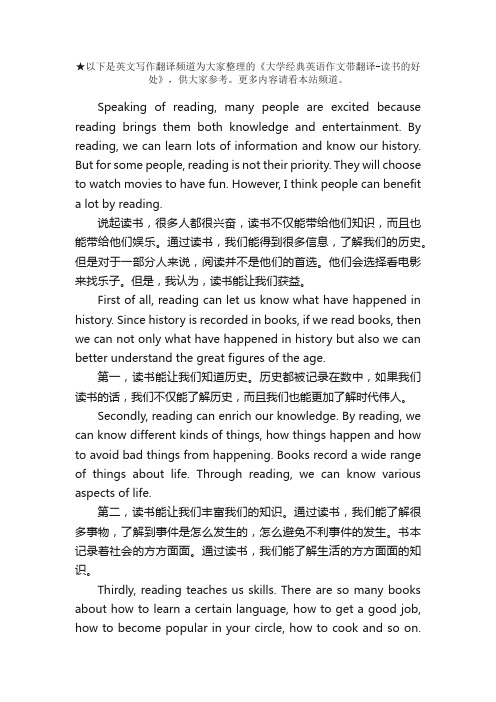
★以下是英文写作翻译频道为大家整理的《大学经典英语作文带翻译-读书的好处》,供大家参考。
更多内容请看本站频道。
Speaking of reading, many people are excited because reading brings them both knowledge and entertainment. By reading, we can learn lots of information and know our history. But for some people, reading is not their priority. They will choose to watch movies to have fun. However, I think people can benefit a lot by reading.说起读书,很多人都很兴奋,读书不仅能带给他们知识,而且也能带给他们娱乐。
通过读书,我们能得到很多信息,了解我们的历史。
但是对于一部分人来说,阅读并不是他们的首选。
他们会选择看电影来找乐子。
但是,我认为,读书能让我们获益。
First of all, reading can let us know what have happened in history. Since history is recorded in books, if we read books, then we can not only what have happened in history but also we can better understand the great figures of the age.第一,读书能让我们知道历史。
历史都被记录在数中,如果我们读书的话,我们不仅能了解历史,而且我们也能更加了解时代伟人。
Secondly, reading can enrich our knowledge. By reading, we can know different kinds of things, how things happen and how to avoid bad things from happening. Books record a wide range of things about life. Through reading, we can know various aspects of life.第二,读书能让我们丰富我们的知识。
大学英语四六级经典阅读:If I Were a Boy Again 假如我又回到了童年.doc

大学英语四六级经典阅读:If I Were a Boy Again 假如我又回到了童年If I were a boy again, I would practice perseverance more often, and never give up a thing because it was or inconvenient. If we want light, we must conquer darkness. Perseverance can sometimes equal g enius in its results. “There are only two creatures,” says a proverb, “Who can surmount the pyramids - the eagle and the snail.”假如我又回到了童年.我会更注意经常磨炼我的毅力,决不因为事情艰难或者麻烦而撒手不管,我们要光明,就得征服黑暗。
毅力在效果上有时能同天才相比。
俗话说:”能登上金字塔的生物,只有两种-鹰和蜗牛。
”If I were a boy again, I would school myself into a habit of attention; I would let nothing come between me and the subject in hand. I would remember that a good skater never tries to skate in two directions at once.假如我又回到了童年,我就要养成全神贯注的习惯;有事在手。
就决不让任何事情分散我的注意力。
我要牢记:优秀的滑冰手从不试图同时滑向两个不同的方向。
The habit of attention becomes part of our life, if we begin early enough. I often hear grown up people say, “I could not fix my attention on the sermon or book, although I wished to do so”, and the reason is, the habit was not formed in youth.如果及早养成这种全神贯注的习惯,它将成为我们生命的一部分。
大学英语四六级经典阅读:Value Youth 珍惜青春.doc
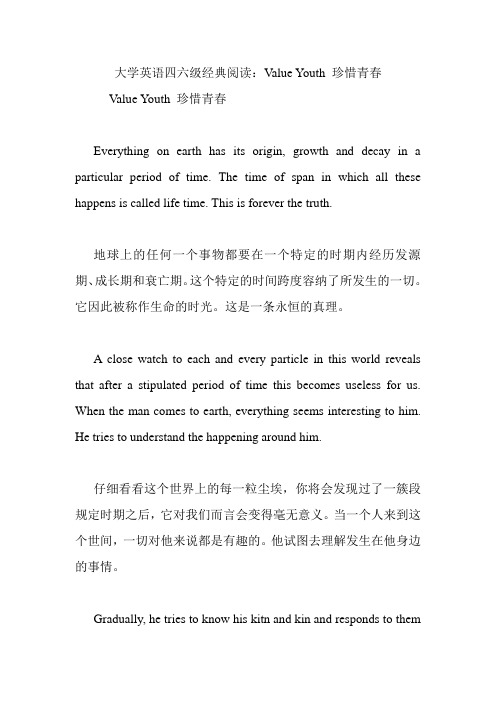
大学英语四六级经典阅读:Value Youth 珍惜青春Value Youth 珍惜青春Everything on earth has its origin, growth and decay in a particular period of time. The time of span in which all these happens is called life time. This is forever the truth.地球上的任何一个事物都要在一个特定的时期内经历发源期、成长期和衰亡期。
这个特定的时间跨度容纳了所发生的一切。
它因此被称作生命的时光。
这是一条永恒的真理。
A close watch to each and every particle in this world reveals that after a stipulated period of time this becomes useless for us. When the man comes to earth, everything seems interesting to him. He tries to understand the happening around him.仔细看看这个世界上的每一粒尘埃,你将会发现过了一簇段规定时期之后,它对我们而言会变得毫无意义。
当一个人来到这个世间,一切对他来说都是有趣的。
他试图去理解发生在他身边的事情。
Gradually, he tries to know his kitn and kin and responds to themwith smiles. With physical growth in course of time, he tries to crawl and starts moving from one place to another.It gives him adequate encouragement and he endeavours to stand on his own feet.渐渐地,他试着去理解他的亲友并且微笑着对其做出回应。
大学英语四六级经典阅读:Slow Down 放慢你的舞步.doc
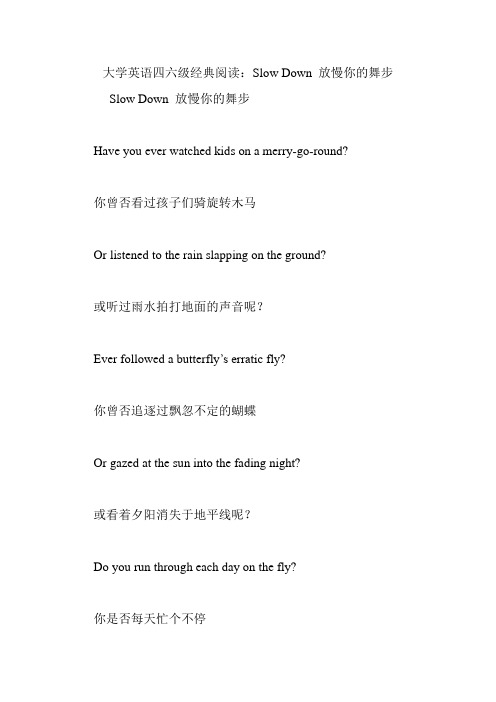
大学英语四六级经典阅读:Slow Down 放慢你的舞步 Slow Down 放慢你的舞步Have you ever watched kids on a merry-go-round?你曾否看过孩子们骑旋转木马Or listened to the rain slapping on the ground?或听过雨水拍打地面的声音呢?Ever followed a butterfly’s erratic fly?你曾否追逐过飘忽不定的蝴蝶Or gazed at the sun into the fading night?或看着夕阳消失于地平线呢?Do you run through each day on the fly?你是否每天忙个不停When you ask “How are you?”, do you hear the reply?当问候别人时,你真的在意他们的回答吗?When the day is done, do you lie in your bed每晚就寝时With the next hundred chores running through your head? 你是否仍在脑海中念叨着无数的杂事呢?You’d better slow down放慢你的舞步Don’t dance so fast不要匆匆忙忙Time is short人生苦短The music won’t last音乐不会永远奏下去。
When you run so fast to get somewhere,当你匆忙赶到目的地时,You miss half the fun of getting there.也就错过了旅途中一半的乐趣。
When you worry and hurry through your day, 当你终日忧心忡忡并马不停蹄时,It is like an unopened gift....就像一份礼物还没被拆开…...Thrown away...就已丢弃……Life is not a race.人生不是一场竞赛。
大学英语作文之阅读经典书籍 The importance of reading classics
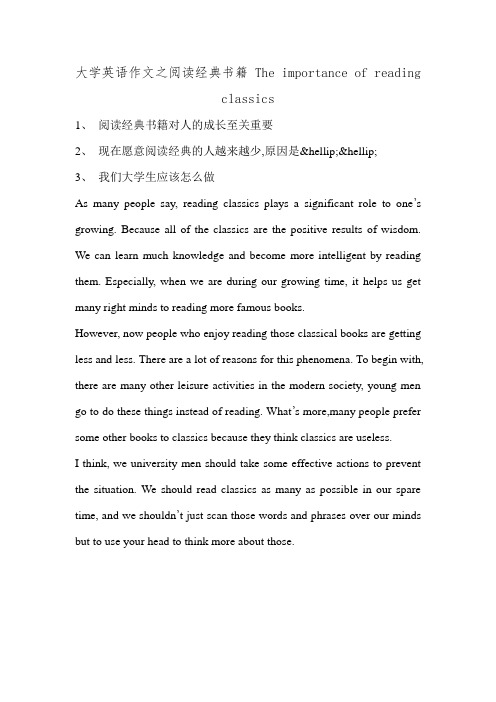
大学英语作文之阅读经典书籍 The importance of readingclassics1、阅读经典书籍对人的成长至关重要2、现在愿意阅读经典的人越来越少,原因是……3、我们大学生应该怎么做As many people say, reading classics plays a significant role to one’s growing. Because all of the classics are the positive results of wisdom. We can learn much knowledge and become more intelligent by reading them. Especially, when we are during our growing time, it helps us get many right minds to reading more famous books.However, now people who enjoy reading those classical books are getting less and less. There are a lot of reasons for this phenomena. To begin with, there are many other leisure activities in the modern society, young men go to do these things instead of reading. What’s more,many people prefer some other books to classics because they think classics are useless.I think, we university men should take some effective actions to prevent the situation. We should read classics as many as possible in our spare time, and we shouldn’t just scan those words and phrases over our minds but to use your head to think more about those.。
大学英语四六级经典阅读:Hour in the Sun 阳光下的时光.doc

大学英语四六级经典阅读:Hour in the Sun 阳光下的时光 Hour in the Sun 阳光下的时光“...I was rich, if not in money, in sunny hours and summer days.”---- Henry David Thoreau“我是富足的,即使没有万贯家产,却也拥有无数个艳阳天与夏日。
”--梭罗When Thoreau wrote that line, he was thinking of the Walden. Pond he knew as a boy. Woodchoppers and the Iron Horse had not yet greatly damaged the beauty of its setting. A boy could go to the pond and lie on his back against the seat of a boat, lazily drifting from shore while the loons dived and the swallows dipped around him. Thoreau loved to recall such sunny hours and summer days “when idleness was the most attractive and productive business.”当梭罗写下这句话时,他正想起从儿时起就相识的瓦尔登湖。
那时,伐木者与火车还未严重破坏湖畔美丽的景色。
小男孩可以走向湖边,仰卧小舟,悠闲地游荡在两岸之间。
在他周围,潜水鸟在戏水,还有燕子轻盈地掠过湖面。
梭罗喜欢回忆这样明媚的时光与夏日。
”此时,悠闲也便成为最具有魅力且颇有裨益的事I too was once a boy in love with a pond, rich in sunny hours and summer days. Sun and summer are still what they always were, but the boy and the pond changed. The boy, who is now a man, no longer find much time for idle drifting. The pond has been annexed by a great city. The swamps where herons once hunted are now drained and filled with houses. The bay where water lilies quietly floated is now a harbor for motor boats. In short, everything that the boy loved no longer exists----except in the man’s memory of it.我也曾经是个热爱湖泊的小男孩.也拥有无数个明媚的阳光与夏日。
大学英语阅读报告范文(优选九篇)

大学英语阅读报告范文(优选九篇)(经典版)编制人:__________________审核人:__________________审批人:__________________编制单位:__________________编制时间:____年____月____日序言下载提示:该文档是本店铺精心编制而成的,希望大家下载后,能够帮助大家解决实际问题。
文档下载后可定制修改,请根据实际需要进行调整和使用,谢谢!并且,本店铺为大家提供各种类型的经典范文,如工作总结、工作计划、合同协议、条据文书、策划方案、句子大全、作文大全、诗词歌赋、教案资料、其他范文等等,想了解不同范文格式和写法,敬请关注!Download tips: This document is carefully compiled by this editor. I hope that after you download it, it can help you solve practical problems. The document can be customized and modified after downloading, please adjust and use it according to actual needs, thank you!Moreover, our store provides various types of classic sample essays for everyone, such as work summaries, work plans, contract agreements, doctrinal documents, planning plans, complete sentences, complete compositions, poems, songs, teaching materials, and other sample essays. If you want to learn about different sample formats and writing methods, please stay tuned!大学英语阅读报告范文(优选九篇)大学英语阅读报告范文(篇一)On Sunday, David asks his mother if he can go to the party.His mother says, "Yes, you can go, but you must be polite.Dont ask for any food.They will give you some." "All right, Mum." David answers and he goes to Roses house on his bike.There are lots of kids at the party.They play together for some time, and then Roses mother gives them some food, but she forgets David.He waits and waits and then he takes his plate up and asks, "Do you want a nice clean plate?"( )1.Whose birthday is it? .A.RosesB.DavidsC.Roses mothers( )2.The birthday party is in .A.Roses houseB.Davids houseC.Roses school( )3.David goes to the party .A.by carB.by bikeC.by bus( )4.David is Roses .A.friendB.classmateC.brother( )5.Who gives David food at the party?A.RoseB.Roses motherC.No one大学英语阅读报告范文(篇二)Thanks for your letter.Im glad you like your school.I go to school from Monday to Friday.We have five classes in the morning and two in the afternoon.And we have many subjects to learn: Chinese, math, English, ., science, biology, music,history and so on.We also have many things to do after class.On Monday and Wednesday afternoons we play sports after class.On Tuesday afternoons some of us have a drawing class, and on Thursdays some have a dancing class.I like music, history and English.But my favorite is music.On Saturdays and Sundays I dont go to ually I go to the park and have a good time with my father and mother there.Love,Lin Fang( )1.Lin Fang has classes a day.A.fiveB.twoC.seven( )2.Some students on Tuesdays.A.play sportsB.have a drawing classC.have a dancing class( )3.Anna likes .A.historyB..C.her school( )4.Lin Fang likes best.A.musicB.EnglishC.history( )5.Lin Fang spends the weekends with in the park.A.AnnaB.her classmatesC.her parents大学英语阅读报告范文(篇三)David is eight.One day his friend Rose says to him, "This Sunday is my birthday.Can you come to my birthday party?" David says, "Yes."On Sunday, David asks his mother if he can go to the party.His mother says, "Yes, you can go, but you must be polite.Dont ask for any food.They will give you some." "All right, Mum." David answers and he goes to Roses house on his bike.There are lots of kids at the party.They play together for some time, and then Roses mother gives them some food, but she forgets David.He waits and waits and then he takes his plate up and asks, "Do you want a nice clean plate?"大学英语阅读报告范文(篇四)英语阅读在英语教学中起着举足轻重的作用,这几年的初中毕业英语试题中,阅读题占总分的55℅,阅读亦为英语学习输入的重要手段。
大学英语经典阅读文章.doc

大学英语经典阅读文章大学英语经典阅读文章篇1How to Make Our College BetterTaizhou University is a local university in Zhejiang Province. As a student of this university, I want to give our school the following suggestions in order to make it better.First, the teachers should work hard to improve their professional level and teaching quality. In teaching, they should pay more attention tofostering students moral sense while passing on knowledge to us students. Second, the collections of books in our library should be increased. It should be a big information provider and an ocean of knowledge for us to explore.Third, a variety of courses aim ed at developing our professional skills should be opened up. Meanwhile, our university should create more opportunities for us students to take part in various social practices so as to enrich our practical experience and make good preparation for our future.Fourth, our university should establish a good and strong relationship with some enterprises where we can get a temporary job during the summer and winter vacations.The last suggestion is that our university should be accessible to the students all over the world. For one thing, it can promote cultural exchange. For another, many excellent management modes can be introduced into our university.In a word, all the students, the staff and the faculty should make their efforts to develop our university. I believe it will have a much brighter future.大学英语经典阅读文章篇2On Playing TruantNowadays, increasing numbers of college students are playing truant, which has become the focus and concern of both teachers and students. There are many reasons to account for their absences from classes.Undoubtedly, the students who play truant are the first to blame for it. Some of them cut their classes because they show no interest in studying. They indulge themselves in surfing the internet or playing computer games. Or they just sleep in the dormitory owing to low temperature outside in winter. Othersvalue making money and gaining working experience more than getting educated. They even devote much of their class time to part-time jobs. Of course, teachers dull lectures are another reason for students failure to attend classes.Repeated absences will do great harm to students themselves, which will affect their ability to finish their course s . It is likely that they will be expelled out of school if they make a habit of skipping classes. It is time to take some efficient measures. Attendance record s should be regularly kept and submitted to school committee if requested so as to maximize their learning opportunity and professional development. To the students, awareness of self-discipline should be raised . To the teachers, their lectures need to be made more interesting, lively and attractive. Anyway, to stop playing truant needs joint efforts from students and teachers.大学英语经典阅读文章篇3The Teacher I Like BestI have been studying for more than twelve years, meeting a variety of teachers. As a student, there is no doubt that teachers often mean so much to me. They not only pass on knowledge to us, but also help us to acquire abilities, skills and develop our mind.I am thankful to those teachers who once taught me. Although years have obscured many names of my teachers, but not the name of my Chinese teacher Wang Xiaofu, who was in charge of my class when I was in high school. In my eyes, she is an extraordinary woman with ordinary appearance. No one thinks she is beautiful but they all agree that she is lovely,confident and eloquent. She enjoys talking and communicating with others. Anyone who has once talked with her is surely attracted by her and has a deep impression of her sharp mind.In addition, her outstanding teaching style also has left a deepimpression on me. As we know, the three years in high school is the toughest period to us students. However, Mrs. Wang tried her best to relieve our stress and pressure. She tried to make us understand that learning means more than immerse ourselves into books. She always encouraged us and after school, she even joined us to play games and do some sports such as running and playing basketball. Though life then was stressful, we experienced sweetness and pleasure of life with my teacher.After class, she is more a friend than a teacher to us all. She treated us as her children and took good care of us. I still remember what she did for me after an important exam. I didn t do well in the exam and was in low spirit. What s worse, my friends didn t talk to me because of my bad temper. I felt so frustrated and confused about what to do next. Mrs Wang realized it and called me out of the classroom. To my surprise, she invited me to have a dinner with her insteadof criticizing me and told me a pile of reasons. At the table she just talked with me happily as if nothing had happened. I understood her intention. She was telling me in a special way: Don t let your frustration last long. Keep calm.All difficulties will be a past thing. I was so moved.That is the teacher I like most. I think I will remember her for ever.大学英语精读(2)、远程学习方法、毛邓三概论作业练习标准答案(2012华师网络教育)11.第2题This is ____________ I want to tell you.A.itB.thatC.whichD.what标准答案:D您的答案:题目分数:1.0此题得分:0.0It makes no difference to me _________ he will come or not.A.howB.whyC.whenD.whether标准答案:D您的答案:题目分数:1.0此题得分:0.03.第4题________the door than somebody started knocking on it.A.I had closed no soonerB.No sooner had I closedC.I had no sooner closedD.No sooner I close标准答案:B题目分数:1.0此题得分:0.04.第5题The instruments of the olderfactory____________.A.is as good or better than the new oneB.are as good or better than the new oneC.is as good as or better than those of the new oneD.are as good as or better than those of the new one标准答案:D您的答案:题目分数:1.0此题得分:0.05.第6题Word has come __________ some guests from Canada will visit our school.A.whatB.thatC.whetherD.when标准答案:B您的答案:题目分数:1.0此题得分:0.06.第7题__________ you don't like him is none of my business.A.WhatB.WhoC.ThatD.Whether标准答案:C您的答案:题目分数:1.0此题得分:0.0___________ is unknown to me.A.Where he isB.Where is heC.He is whereD.Is he where标准答案:A您的答案:题目分数:1.0此题得分:0.08.第9题I have no idea_________ they have kept in touch with me by E-mail since last year.A.whatB.howC.thatD.when标准答案:C题目分数:1.0此题得分:0.09.第10题I recognized her____________I saw her.A.the instant (that)B.afterC.if notD.unless标准答案:A您的答案:题目分数:1.0此题得分:0.010.第11题Mrs. Lee will move into her new house next Monday, ____________it will be completely furnished.A.by that timeB.by the timeC.by which timeD.by some time标准答案:C您的答案:题目分数:1.0此题得分:0.011.第23题No one was aware ____________Jane had gone.A.where thatB.of the placeC.of whereD.the place标准答案:C您的答案:题目分数:1.0此题得分:0.012.第24题Young ___________John was, he was able to swim across the channel within minutes.A.asB.soC.thoughD.although标准答案:A您的答案:题目分数:1.0此题得分:0.013.第25题We don't doubt ____________ he can make a good job of it.A.ifB.thatC.whatD.why标准答案:B您的答案:题目分数:1.0此题得分:0.014.第26题I was sure __________ I would overcome all these difficulties.A.whatB.thatC.whichD.whether标准答案:B您的答案:题目分数:1.0此题得分:0.015.第27题He told me the news ___________ our team had won the game.A.aboutB.ofC.asD.that标准答案:D您的答案:题目分数:1.0此题得分:0.016.第28题I have not found my book yet. In fact, I'm not sure ____________ I could have done with it.A.ifB.whetherC.howD.what标准答案:D您的答案:题目分数:1.0此题得分:0.017.第29题Students in his class cannot understand____________.A.what does the sentence meanB.what means this sentenceC.what this sentence meansD.what is the meaning of the sentence标准答案:C您的答案:题目分数:1.0此题得分:0.018.第30题The news____________ to the Great Wall during the summer holidays made us very happy.A.what we would goB.how we would goC.that we would go。
- 1、下载文档前请自行甄别文档内容的完整性,平台不提供额外的编辑、内容补充、找答案等附加服务。
- 2、"仅部分预览"的文档,不可在线预览部分如存在完整性等问题,可反馈申请退款(可完整预览的文档不适用该条件!)。
- 3、如文档侵犯您的权益,请联系客服反馈,我们会尽快为您处理(人工客服工作时间:9:00-18:30)。
Unit 2 Text A Smart Cars1.Teaching Plan1.1Objectivesa. grasp the main idea-What can smart car do?;b. grasp the structure;c. employ a variety of techniques in expository writing (definition, quotes, a mixture of facts and opinions, etc.);d. master the key language points and grammatical structures in the text;e. conduct a series of reading, listening, speaking and writing activities related to the theme of this unit.1.2 Time Allotmenta. Pre-reading (1st period): activities (e.g. questions or dictations) to lead in to the text; PartⅠ; comprehension; text organization.b. While-reading (2nd period): language points and grammatical structures.c. While-reading (3rd period): text analysis.d. Post-reading (4th period): main idea, exercises, and importantly, Theme-related Language Learning Tasks (Part Ⅳ).e. Post-reading (5th period): check on Ss’ home assignments.2. Cultural Notesa. Automobile industry:The automobile industry is one of the most important industries in the world, affecting not only economies but also cultures. It provides jobs for millions of people, generates billions of dollars in worldwide revenues, and provides the basis for a multitude of related service and support industries. Automobiles revolutionized transportation in the 20th century, changing forever the way people live, travel, and do business.Between 1886 and 1898, about 300 automobiles were built, but there was no real established industry. A century later, with automakers and auto buyers expanding globally, auto making became the world's largest manufacturing activity, with more than 53 million new vehicles built each year worldwide.Automobile manufacturers are among the largest companies in the world. These corporations are often multinational. These companies often share parts, or use parts made in foreign factories. The U.S. automobile industry produced 16.8 million vehicles in 1999. The three major automobile manufacturers in the United States--General MotorsCorporation, Ford Motor Company, and Daimler Chrysler AG--provide three fourths of the industry's total direct employment in the United States.b.Global Positioning SystemGlobal Positioning System is a space-based radio-navigation system, consisting of 24 satellites and ground support. GPS provides users with accurate information about their position and velocity, as well as the time, anywhere in the world and in all weather conditions.GPS determines location by computing the difference between the time that a signal is sent and the time it is received. GPS satellites carry atomic clocks that provide extremely accurate time.As of March 1994, 24 GPS satellites were in operation. Replenishment (补给) satellites are ready for launch, and contracts have been awarded to provide satellites into the 21st century. GPS applications continue to grow in land, sea, air, and space navigation. The ability to enhance safety and to decrease fuel consumption will make GPS an important component of travel in the international airspace system. Airplanes will use GPS for landing at fogbound (为浓雾所困的) airports. Automobiles will use GPS as part of intelligent transportation systems. Emerging technologies will enable GPS to determine not only the position of a vehicle but also its altitude.c. Intelligent Transportation Systems:Intelligent Transportation Systems (ITS) refers to transportation systems which apply emerging hard and soft information systems technologies to address and alleviate (缓解) transportation congestion problems.For example, using advanced surveillance (监视) systems, the early stages of a traffic bottleneck situation can be detected, and traffic can then be directed to other routes to mitigate (减轻) the congestion and to provide faster and more efficient routes for travelers.New technologies enable this type of surveillance and guidance response to occur in real time, and therefore, to allow potential congestion situations to be addressed before they develop into serious traffic jam.3. Pre-reading Activities (Dictations or Discussions)3.1. Group Discussion:a.How do you understand “smart cars”?b. What is an ideal car like in your imagination?Car of the Future 未来的汽车自动,省油,容易操作,舒适,便宜,无污染Don’t Have Accidents Never Get Lost Can’t Be Stolen Never Get Caught in Traffic JamsDrive Themselves Don’t Guzzle Gas Don’t PolluteDon’t Have to Wait at Toll BoothsNever Spin Out of Control Surf the InternetNever Break DownAre Very EntertainingHighway (L63): 公路,国道Freeway (Am also Expressway or Interstate Highway)Motorway (U.K)Underground / subway/tubeLight rail (elevated railway)Inner-ring roadOuter-ring roadElevated road; viaduct 高架Over-pass 天桥Mag-lev train: Magnetically levitated train1)Motorway : (in Britain) a wide road, with at least two lanes in each direction, where traffic can travel fast for long distances between large towns. (英国)高速公路.是快车道.2) Highway : A main road, usually connecting large towns interstate.一般的公路;交通要道 .(尤指美国)州与州之间的,州际的例: Highway patrol. (美国)州际公路巡警.3) Expressway: A major divided highway designed for high-speed travel, having few or no intersections / Large, well-travelled road . 高速公路, 又称Limited access highway.区别:a) A highway is a main road.b) An expressway is a multilane highway; freeway, parkway, turnpik e(收费公路)are types of expressways.4) Freeway: (US) a wide road, with at least two lanes in each direction, where traffic can travel fast for long distances between large towns. (美国)高速公路.有別于 Tollway ( 要收过路費的高速公路), Freeway 不收钱.c. The merits and demerits of cars:Some scientists and engineers come up with the idea of a “smart car”. Let’s have a look at what “smart car” is.z What does “smart” mean?z Why do people like cars?z What do you think “smart cars” can do and what do they depend on?z What other words are used related to cars? windscreen前窗windscreen wiper雨刷sunroof天窗 Trunk后箱b umper保险杠 dashboard仪表盘 headlight前灯 rear light尾灯fog light雾灯 side mirror侧视镜r earview mirror后视镜horn喇叭seat belt安全带steering wheel方向盘 gas pedal油门brake刹车hand brake手刹z Relevant Information1. The invention of cars:The first self-propelled car was built by Nicolas Cugnot古诺 in 1769 which could attain speeds of up to 6 kms/hour. In 1771 he again designed another steam-driven engine which ran so fast that it rammed into a wall, recording the worlds’ first accident机动车事故.2. Some famous brands of cars:1、SPYKER(世爵)-荷兰2、Maybach(迈巴赫) - 德国3、Bentley(宾利) - 英国4、Rolls-Royce(劳斯莱斯) - 英国5、Lincoln(林肯) - 美国6、Bugatti (布加蒂)- 法国7、Ferrari(法拉利) - 意大利8、Lamborghini(兰博基尼)意大利9、Aston Martin(阿斯顿马丁)英国10、Mercedes-Benz(梅塞德斯-奔驰) - 德国11、Porsche(保时捷) - 德国12、BMW (宝马)- 德国13、Cadillac(凯迪拉克) - 美国14、Hummer(悍马) - 美国15、Maserati(玛莎拉蒂)意大利16、Jaguar(美洲虎) - 英国17、Audi(奥迪) - 德国18、Land Rover(陆虎) - 英国19、 Mini (迷你)- 英国(德国)20、V olvo(沃尔沃) - 瑞典21、V olkswagen(大众) - 德国22、Acura (极品/阿库拉)- 日本23、Jeep(吉普)- 美国24、Lexus(凌志) - 日本25、Saab(绅宝) - 瑞典26、Infiniti(无限) - 日本27、Toyota(丰田) - 日本28、Chrysler(克莱斯勒) - 美国29、Buick(别克) - 美国30、Peugeot(标致) - 法国31、Citron(雪铁龙) - 法国32、Alfa RoMeo(阿尔法.罗密欧)- 意大利33、Honda(本田) - 日本34、Ford(福特) - 美国35、Opel(欧宝) - 德国36、Nissan(日产/尼桑) - 日本37、Renault(雷诺) - 法国38、Mazda(马自达) - 日本39、Mitsubishi(三菱) - 日本40、Subaru(斯巴鲁) - 日本41、MG(美格) - 英国42、Fiat(菲亚特) - 意大利43、Smart(斯玛特) - 德国44、Hyundai(现代) - 韩国45、Skoda (斯柯达)- 捷克46、Kia(起亚) - 韩国47、Dodge(道奇) - 美国48、Ssangyong(双龙) - 韩国49、Suzuki(铃木) - 日本50、Seat(西亚特)-西班牙51、Chevrolet(雪佛兰) - 美国52、Red Banner (红旗) - 中国53、Qirui (奇瑞)-中国54、GreatWall (长城) - 中国55、Chonghua (中华)-中国56、Changan (长安) - 中国57、Byd(比亚迪)-中国58、Daihatsu (大发) - 日本59、Proton(宝腾) - 马来西亚60、Tata(塔塔) - 印度z General Motors大众 General Motors (GM) has steered around competitors to remain the world's #1 maker of cars and trucks, with brands such as Buick, Cadillac, Chevrolet, GMC, Pontiac, Saab, Saturn, and Oldsmobile (which is being discontinued).z Ford Motor Company福特 Ford Motor Company offers a wealth of variety to the automotive consumer. Vehicle Brands Ford Lincoln Mercury Mazda V olvo Jaguarz Land Roverz Aston Martinz DaimlerChrysler (戴姆勒-克莱斯勒): DaimlerChryslers’ passenger car brands include Maybach, Mercedes-Benz, Chrysler, Jeep®, Dodge and smart. Commercial vehicle brands include: Mercedes-Benz,Freightliner,Sterling, WesternStar and Setra..z Toyota丰:Toyota is a world famous brand of cars. The company is in Japan.z Mercedes-Benz梅塞德斯-奔驰 This brand has stood for more than 100 years. It is a German company.4. Language Study1)eliminate: remove, esp. sb./sth. That is not wanted or needed; get rid of (usedin the patterns: eliminate sth.; eliminate sth. from sth.); (often passive) to defeat someone so that they cannot continue in a competitione.g. If you think you may be allergic to the food or drink, eliminate it from your diet. The Chinese government approved a new plan to eliminate illiteracy nationwide by 2006.我们能把饥饿从地球上根除吗?Can we ever eliminate hunger from the world?我们队在(竞赛)的第一轮就被淘汰了。
